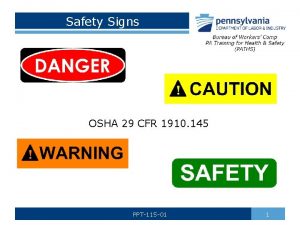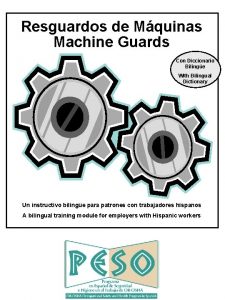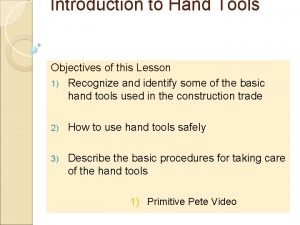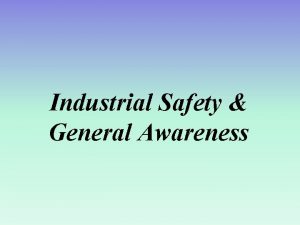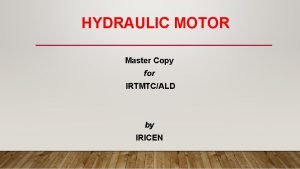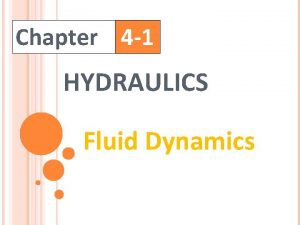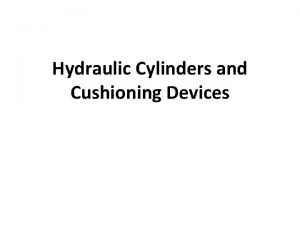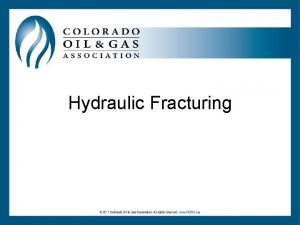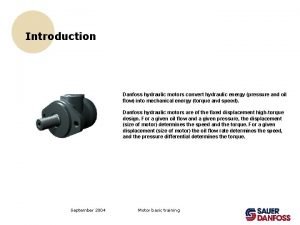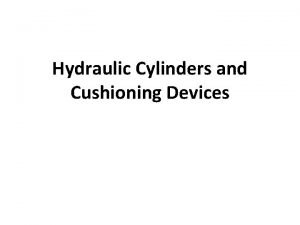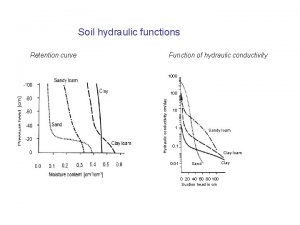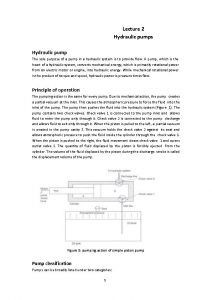Industrial Hydraulic Safety 1 Industrial Hydraulic Safety Hydraulic






















- Slides: 22

Industrial Hydraulic Safety 1

Industrial Hydraulic Safety Hydraulic systems store fluid under very high pressure – typically, at 2, 000 pounds per square inch… Hazards: Ø stored energy • flailing hydraulic hose, ejected components • maintenance conducted without releasing pressure • maintenance conducted after incorrectly releasing pressure Ø temperature Ø ignition Ø injection

Industrial Hydraulic Safety Skin will scald at 120°F Two to three minutes at that temperature will result in a 2 nd degree burn. The average operating temperature of a hydraulic system of 140°F will cause a 2 nd degree burn in ½ to 1 second. 3

Industrial Hydraulic Safety • Oil adheres to the skin and the longer the contact, the deeper the burn. • Burn injuries are the worst type of injury from a rehabilitation point of view. • The rule of thumb is: one day in hospital for each 1% of body area burned. Employee was burned when a hydraulic hose, neglected during maintenance, burst and spewed hydraulic oil, at normal operating temperature, over his entire body. 4

Industrial Hydraulic Safety Fire and Explosion Risks of Hydraulic Fluid • High flash point: 300 -600°F • Under pressure, atomised spray of droplets may travel a considerable distance from the break • Ignites readily by heat source • Resulting fire is torch-like with very high heat release rate • Mist in confined area can explode violently

Industrial Hydraulic Safety Never use hands or fingers to find leaks. Fluid under high pressure can be injected into the skin causing extreme injury, serious infection – gangrene – and amputation 6

Industrial Hydraulic Safety Fluid Injection wound and the extent of surgery needed to treat it 7

Industrial Hydraulic Safety Always inspect equipment before each use. Also have a periodic maintenance plan in place for extensive inspection and replacement of parts at end of their service life. 8

Industrial Hydraulic Safety Hydraulic Fluid Injection Case • Pipe being pressure-tested on drilling rig at 6, 000 psi • As operator reached inside an enclosure box to operate pressure relief valve, hand brushed against pipe to valve, just as the pipe split. • Fine jet of oil made a ¼-inch cut in hand, with ½-inch circle of lifted skin around it. • Felt like being punched in the palm. • No pain 9

Industrial Hydraulic Safety Hydraulic Fluid Injection Case • Rushed to hospital • Pain increasing • In surgery 5 hours after incident, began removing oil • After surgery, morphine ineffective for pain relief • With local anaesthetic to hand, undid stitches and searched for more oil • Second surgery on day three 10

Industrial Hydraulic Safety Hydraulic Fluid Injection Case • Skin turned black on little finger • Carpal tunnel opened to relieve pressure • Massive swelling crushing nerves • Cut away side of hand “eaten” by oil • Third surgery on day five • More flesh cut away and grafts begun • Drugs for pain finally working 11

Industrial Hydraulic Safety 12

Industrial Hydraulic Safety Hydraulic Fluid Injection Case • 14 days in hospital • Weekly physiotherapy • 3 months later, fourth surgery to release little finger that had curled into palm • 9 months later, fifth surgery • Off work for six months • 3 skin grafts with scarring to thigh and arm 13

Industrial Hydraulic Safety Hydraulic Fluid Injection After Recovery 14

Industrial Hydraulic Safety Inspect Hydraulic Equipment Defective Hydraulic Hoses Hydraulic hoses should be inspected daily 15

Industrial Hydraulic Safety Always Relieve Hydraulic Pressure Before Performing Maintenance 16

Industrial Hydraulic Safety Hydraulic Hose Whip 17

Industrial Hydraulic Safety Industrial Accident – High Pressure Line Whip Cut 18

Industrial Hydraulic Safety Working with Hydraulic Oils • Avoid prolonged breathing of its vapor, mist, and fumes. • Avoid prolonged or repeated skin contact. • Use chemical-resistant gloves, splash goggles and a chemical-resistant apron • Wash off affected skin, eyes, and protective clothing immediately. Remove contaminated clothing, and launder before reuse. • After contact with hydraulic oil always cleanse skin with a waterless hand cleanser, and then wash with soap and water. 19

Industrial Hydraulic Safety Working with Hydraulic Systems • Never begin work on a hydraulic system until fully trained. • Carefully review the manuals on equipment before beginning work and ask questions about anything you do not fully understand. • Review all Material Safety Data Sheets (MSDS) for all chemicals used. • Use all required personal protective equipment. – – – Safety goggles "and" face shield Protective apron Protective gloves Hard hat Steel toes leather shoes 20

Industrial Hydraulic Safety Working with Hydraulic Systems • Always relieve pressure before performing any maintenance on a hydraulic system • Use extreme caution when disconnecting hydraulic lines. • Clean up spills immediately. Hydraulic fluid can cause slips, falls and resulting injuries. • Do not work under equipment / apparatus being supported by hydraulics. – Stops, safety pins, etc, must be in place before repairs begin. 21

Industrial Hydraulic Safety Summary • The risks of work with hydraulic systems are not only of high-pressure puncture accidents, but of fire, lacerations, severe burns, crushing and death. • These risks apply to maintenance workers, forklift and other hydraulic equipment, millwrights, and welders, etc. • Anyone whose work entails the operation of machines – whether they be milling machines or bulldozers – that use hydraulic pressure systems. 22
 Osha safety signs and symbols
Osha safety signs and symbols Machine tools supply
Machine tools supply Industrial safety belt specification
Industrial safety belt specification Aramco industrial security
Aramco industrial security Hand tools
Hand tools Objectives of industrial safety
Objectives of industrial safety Safety care training
Safety care training Basic safety construction site safety orientation
Basic safety construction site safety orientation Process safety vs personal safety
Process safety vs personal safety Ind safety report
Ind safety report Where do you activate the four shades function for the encs
Where do you activate the four shades function for the encs Basic safety orientation
Basic safety orientation Hydraulic motor converts
Hydraulic motor converts Hydraulic fluid conditioning
Hydraulic fluid conditioning Aircraft hydraulic systems
Aircraft hydraulic systems Hydraulic structures
Hydraulic structures Hydraulic to air brake conversions
Hydraulic to air brake conversions Hydraulic topsoil darwin
Hydraulic topsoil darwin Continuity equation hydrology
Continuity equation hydrology Hydraulic interface units
Hydraulic interface units Hydraulic diameter formula
Hydraulic diameter formula Head loss formula
Head loss formula Double pump hydraulic system
Double pump hydraulic system
